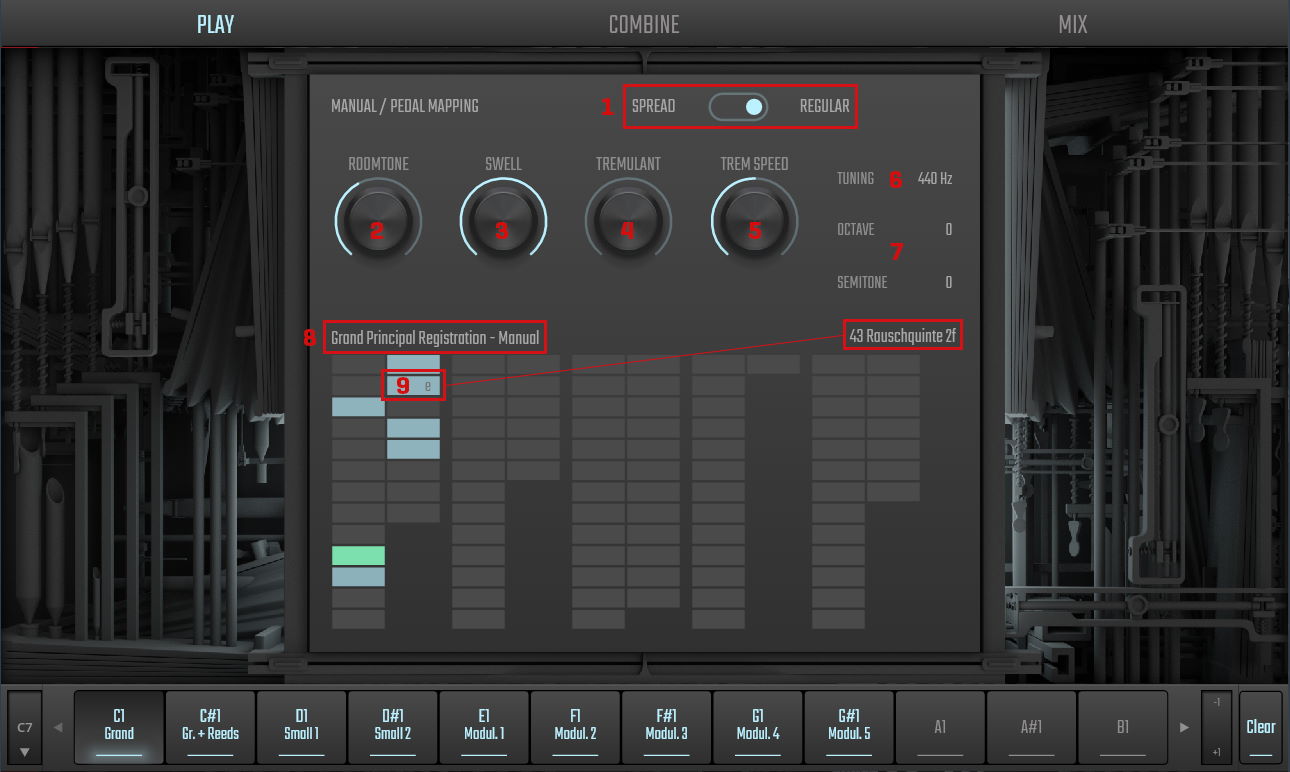The PLAY tab gives you access to the player's most necessary control features for a performance, be it a recording session or a live gig.

- The SPREAD / REGULAR switch is a kind of sub-preset concerning stop transpose and range data, so that you can switch between two different keyboard mappings.
The default setting for “regular” represents the common playing range of organ manuals (C2–A6) and pedal (C2–F4), and “spread” adapts it to, e.g., an 88-key master keyboard, with the pedal ranging from C1 to B2 and the manuals from C3 to A7. To accommodate this extended layout, the bank switches are shifted to C0–B0 and the combination switches to C~–B~. - ROOM TONE is only displayed if the selected organ features it (e.g., Great Rieger Organ), and adjusts the amount of the organ's ambient sound at the player's position which can also be heard (however faintly) when the organ is not played. Right-click for controller options. Please note that Room Tone will be disabled after 30 Minutes of inactivity (i.e., no note-on message).
- SWELL simulates the effect of pipes being shuttered off in a swell box. 100% means fully open and unmuffled. The lower its setting, the more muffled the sound. By default, SWELL is controlled with MIDI CC11. Right-click for channel routing and controller options.

- TREMULANT modifies the air supply, resulting in tremolo and slight vibrato. By default, TREMULANT amount is controlled with MIDI CC20. Right-click for channel routing and controller options.
- TREM SPEED adjusts the frequency of TREMULANT on a scale from 0 to 10. Right-click for controller options.
- TUNING can be adjusted between 420 and 460 Hz. Drag, or double-click to enter a value on the keyboard. Cmd/Ctrl-click resets to 440 Hz.
- OCTAVE and SEMITONE enable you to shift the samples to a different position on the keyboard. This means that if you increase the octave value by 1, if you hit C5 you will hear the tone normally played on C6 (with the organ, the actual pitch depends on the registration), and similarly with the semitone value. In this way you can adapt the keyboard to your needs, e.g., if otherwise you would have to play in a key you are unfamiliar with. Like the TUNING value, these parameters can be edited by dragging or double-clicking and entering a value, and reset to zero with Cmd/Ctrl-click.
- The name of the active combination can be edited by double-clicking on it.
- When hovering over a stop, its name is displayed on the right side above the manual/pedal blocks. As in the COMBINE tab, you can activate and deactivate stops, as well as edit their parameters, allowing for quick changes to your instrument.